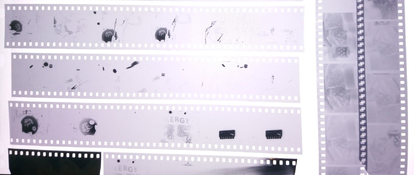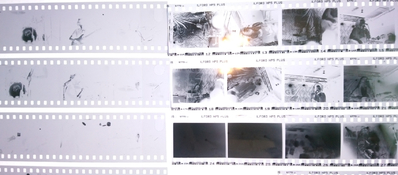Hi there,
For reasons that aren't worth explaining, I'm on the road with a single-roll Paterson tank, a changing bag, a bottle of American HC-110, and a whole bunch of rolls of AristaEDU 400 shot at 3200. I'm well aware that that's nobody's favorite combo, but that's what I've got. My goal is to recover those latent images before I have to fly.
I learned that I have a problem when I guessed at what I thought would be a reasonable development time, and got completely unusably thin negatives. For that, I tried dilution A (1+15) for 11 minutes, 20s initial agitation + 3 inversions every 30s. The images are basically lost. The leader is fully darkened, but clearly thin when held up to a light. This tells me: "needs more development time."
I also had some HP5+ rolls, also at 3200, which developed very nicely with the same process for 9.5 minutes. So the developer is good.
I shot a test roll of Arista and cut it into 4 strips:
The other two test strips are sealed awaiting better ideas. So... any better ideas? Otherwise I'm going to try 1+15 for 30 minutes and semi-stand in 1+31 dilution.
I ensured at least 6ml of HC-110 concentrate in all attempts. Semi-stand was exactly 6ml, the others were 36ml. All rolls are brand new, though I note that Arista doesn't print expiration dates??
I fear that it really didn't get enough light to even produce a latent image, but I have seen images around the net indicating people have successfully pushed Arista/Foma 400 to 3200. I get that it will be crazy contrasty, which is fine, as long as there's... ya know, an image.
The attached images give a rough comparison. It looks slightly better than reality after the cell phone processing... in person, I struggle to tell there's anything in some of these frames. The first is the three Arista attempts, the second is Arista vs HP5+. When only looking at the Arista you might think "yeah, there's maybe some image here", but compared to HP5 you can see that truly nothing came out. These are same camera, same place, same settings, same lighting.
Thanks!
For reasons that aren't worth explaining, I'm on the road with a single-roll Paterson tank, a changing bag, a bottle of American HC-110, and a whole bunch of rolls of AristaEDU 400 shot at 3200. I'm well aware that that's nobody's favorite combo, but that's what I've got. My goal is to recover those latent images before I have to fly.
I learned that I have a problem when I guessed at what I thought would be a reasonable development time, and got completely unusably thin negatives. For that, I tried dilution A (1+15) for 11 minutes, 20s initial agitation + 3 inversions every 30s. The images are basically lost. The leader is fully darkened, but clearly thin when held up to a light. This tells me: "needs more development time."
I also had some HP5+ rolls, also at 3200, which developed very nicely with the same process for 9.5 minutes. So the developer is good.
I shot a test roll of Arista and cut it into 4 strips:
- first, I tried nearly doubling the time: 1+15 for 20 minutes. They look pretty much equally thin. Still completely unprintable. This was a surprise, I thought doubling the time might over-develop.
- second, I tried semi-stand: 1+99 for 50 minutes, with 60s hard shaking at the start and at the halfway point. This looks more or less identical, practically no image recovered. Again, if there was anything in the shadows I would have expected it to come out.
The other two test strips are sealed awaiting better ideas. So... any better ideas? Otherwise I'm going to try 1+15 for 30 minutes and semi-stand in 1+31 dilution.
I ensured at least 6ml of HC-110 concentrate in all attempts. Semi-stand was exactly 6ml, the others were 36ml. All rolls are brand new, though I note that Arista doesn't print expiration dates??
I fear that it really didn't get enough light to even produce a latent image, but I have seen images around the net indicating people have successfully pushed Arista/Foma 400 to 3200. I get that it will be crazy contrasty, which is fine, as long as there's... ya know, an image.
The attached images give a rough comparison. It looks slightly better than reality after the cell phone processing... in person, I struggle to tell there's anything in some of these frames. The first is the three Arista attempts, the second is Arista vs HP5+. When only looking at the Arista you might think "yeah, there's maybe some image here", but compared to HP5 you can see that truly nothing came out. These are same camera, same place, same settings, same lighting.
Thanks!
Attachments
Last edited:














